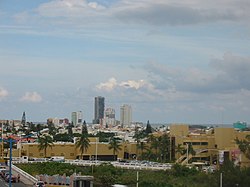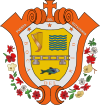Boca del Río, Veracruz
| Boca del Río | ||
|---|---|---|
| City & Municipality | ||

View of central Boca del Rio to the southwest, taken from the "Puente de Amistad" (Friendship Bridge)
|
||
|
||
| Location in Mexico | ||
| Coordinates: 19°06′20″N 96°06′28″W / 19.10556°N 96.10778°WCoordinates: 19°06′20″N 96°06′28″W / 19.10556°N 96.10778°W | ||
| Country |
|
|
| State | Veracruz | |
| Founded | 1520s | |
| Government | ||
| • Municipal President | Miguel Ángel Yunes Márquez (PAN) | |
| Area | ||
| • Municipality | 42.77 km2 (16.51 sq mi) | |
| Elevation (of seat) | 16 m (52 ft) | |
| Population (2010) | ||
| • Municipality | 138,058 | |
| • Seat | 9,947 | |
| Time zone | CST (UTC-6) | |
| Postal code (of seat) | 94290 | |
| Climate | Aw | |
| Website | (Spanish) Municipal Official Site | |
Boca del Río is a city and municipality located in the center of the Mexican state of Veracruz. The small city of Boca del Río serves as the seat of the municipality. The municipality lies just south of the municipality of Veracruz, and contains a part of the city and city and port of Veracruz. It is a port in its own right, as well as the metropolitan area’s center for business travel and upscale hotels and restaurants. The city contains two museums, one dedicated to Agustín Lara and the other a military ship that has been converted into a museum. However, the municipality's main feature is the World Trade Center Veracruz, which hosts business meetings, conferences and conventions.
The name “Boca del Río” is from Spanish, meaning “mouth of the river” and refers to the mouth of the Jamapa River as it flows into the Gulf of Mexico. The pre-Hispanic name for the area was Tlapaquitan, which means “divided land.”
From 1000 to 1200 BCE, the area was under Olmec domination. The area officially came under Aztec domination in 1474 and is mentioned in the Codex Mendoza as part of the district of Cuetlachtlan. However, the Aztecs had been active here for sometime before that. In 1518, Juan de Grijalva came to the area with his crew and named the river “Río de las Banderas” because they saw indigenous peoples communicating across the river with flags. In the same year, the first Christian rites were performed at a chapel called Nuestra Señora de Santa Ana. In 1879, the localities of Hacienda de Santa Maria Punta, Hato and Anton Lizardo were separated from the municipality and joined with neighboring Alvarado municipality. In 1892, the Veracruz- Tierra Blanca rail line was built, passing through Boca del Río. The settlement gained city status in 1988.
From the early 2000s, crime and pollution have been the city’s major challenges. Like much of the rest of Mexico, drug trafficking causes significant incidents of violence such as the ambush and murder of three agents of the Inter-municipal Police and the murder and mutilation of rivals. There is a problem with the theft of aluminum and copper cables from certain parts of the city but the major crime story to date has been the theft of over 1 million pesos worth of merchandise, mostly jewelry and watches, from the Ejército Mexicano branch of the Nacional Monte de Piedad. The thieves had cut a hole in the back wall of the building and then cut the alarm system and cameras to work their way into the vault.
...
Wikipedia


